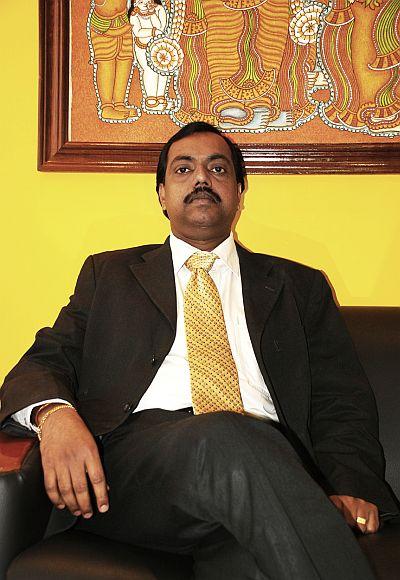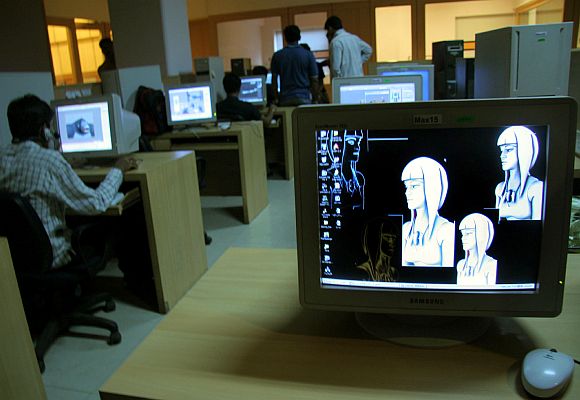 | « Back to article | Print this article |
'India does not have good story tellers'
India’s animation industry lacks the skill to tell a story that is simple, universal and can be understood by global audience, Toonz Animation India’s CEO P. Jayakumar tells Shobha Warrier.
Toonz Animation India, the first animation studio in the country, is rated as one of the top studios in Asia. It was also the first to set base at the lush green campus of Technopark in Thiruvanathapuram.
In an interview at its facility in Technopark, CEO P. Jayakumar talks about the company’s journey since its inception and the changing dynamics of India’s animation industry.
From 1999 to 2013, how much has the animation industry changed?
When we started the company, there was no animation industry in India. In scale and size, Toonz started it all.
The major problem we faced at that time was talent. Raw talent was available in places like Maharashtra, Bengal and Kerala but we could not get experienced animators.
We had to bring them from abroad and train our people. At that time, we had around 50 people from outside India working here to make sure that our people got international exposure.
Were your clients happy with the products you delivered?
Our first client was Cartoon Network, Hong Kong. When we first started working with them, we immediately realised that we will not be able to deliver international quality product and services.
That was when we decided to bring in animators from Australia, America, London, Singapore, and a lot of people from Philippines.
Within six months it started showing results. Still, we continued with the expatriate animators for another 3 years.
Click NEXT to read more…
'India does not have good story tellers'
Was it not expensive to hire international animators?
It was a heavy drain on our resources as companies outsourced their work to us because we offered a price advantage. But with 50-60 animators from outside, we killed the price advantage.
But we look at it as an investment cost for the talent. We must have spent $10-15 million in training raw talent in the early years.
Even today, there is no dearth of talent available. It needs to be polished.
Today, there are a lot of training institutes in India, including few serious ones such as the IITs. A new company, therefore, need not spend the kind of money we spent those days.
How do you compare the market for animation then and now?
If you look at the industry from the market perspective, it has grown tremendously. The Indian market was worth only $10-15 million then.
But today, it is more than a billion dollar. Still, it is very small compared to the global market, which is around $150 billion.
Which are the biggest markets?
We call nine countries as the key markets - America, Australia, Canada, Japan, South Korea, UK, Germany, Spain, Italy.
North America contributes up to 40 per cent of the world business while Europe contributes 26 per cent, about 8 per cent business comes from Japan. Other countries put together contribute the rest.
Click NEXT to read more…
'India does not have good story tellers'
Has the perception towards Indian animators and animation films changed over the years?
When we talk about animation films, there are two stages of production - one is the ideation stage where you write the script, story board, etc and the other is animation production and pre-production.
We are far behind international standards on the ideation side. We are at a very nascent stage and we do not have any good story tellers.
When I say story tellers, I mean story tellers to tell stories that can be understood by the entire world. We are at par with international standards in production but not in story telling.
What about our long history of stories like the Panchatantra, Jataka tales, Mahabharata, etc?
The content which is consumed by the western world and India are very different. They don't identify with our stories and the biggest market for animation is there.
On the other hand, the stories told by the American studios travel all around the world, as they are simple and universal.
Our stories are complex and our story telling also is complex. But we can take some simple story from Mahabharata and make it into a film for the global audience.
Look at the way Kung Fu Panda is adapted by the Americans and made into an animation film!
Click NEXT to read more…
'India does not have good story tellers'
What about films? Why is it that we do not have many animation feature films?
Unlike in the US, adults do not go and watch an animation film in India; they look at this as kid stuff. The mindset has to change.
In feature animation, we are far behind and the market has not matured. The only films that made money are Hanuman and Chota Bheem. Except these two, all other films have bombed.
As far as TV animation is concerned, there is a huge market in India. We have all the major international networks in the country.
Ten years ago, we produced India's first animation series, Tenali Raman. Today, we get ten times more than what we got for this series. The TV market in India is exponentially growing, as there is an appetite for local content.
The only problem is it costs a lot of money to produce original content. Almost all the countries offer sops to the animation industry but there is none in India.
The only thing we have is the cost advantage. It requires at least Rs 20 lakh (Rs 2 million) to produce a half-hour animation film compared to the Rs 200,000 or so for a serial.
Isn't the shelf life of an animation film much more?
Yes, that is the beauty of an animation film. Look at Tom and Jerry. It was made 70 years back but it is still making money.
Click NEXT to read more…
'India does not have good story tellers'
When we spoke in 2008, you had said that India should be producing films and not doing the outsourcing work. Have you started producing films?
We have moved on from outsourcing to film production. When you do service work, you don't add any value. Also, the margins are much less and very subjective.
Money is in creating franchises and only then, you start making money. You need to own intellectual properties in order to add value to the company. From 2004 onwards, we have been doing that.
It must have been a big shift from what you were doing until then...
Yes, it was a big shift and also a big risk. We invested Rs 6 crore (60 million) upfront to make Thenali Raman and were paid later.
But today, broadcasters bring in the money to produce. We don't need to invest money. We develop an idea and pitch it to broadcasters and they commissions it.
What are your priorities now - your own production or doing services for international studios?
We have two divisions now; one is APAC which is Asia Pacific Content. We are now number one in India and probably number one in Asia as well, working with all the broadcasters. We do business for around $10 million.
Our core business is still international, mainly animation films for international studios. Investment for some of these projects is around $10 million.
Most of the time, we do the pre and post production in the US and the production here in our studios. And, these projects are sold all over the world.
Click NEXT to read more…
'India does not have good story tellers'
Does that mean projects can be sold irrespective of the place from where it is produced?
Absolutely. It is all about how distinct your product is. Broadcasters only look your production value and uniqueness of your story. It does not matter where you are from.
How much has the Indian animation industry grown in the last few years?
Nasscom figures say it has grown by 30 per cent in the last 2-3 years. When the entertainment industry was growing at 19 per cent, animation industry was growing faster.
But our share of the global pie is very small. It is a $1 billion industry growing at 30 per cent, and it may take 2-3 years to become a $2 billion industry.
If the government comes and gives the industry a policy introduction, it may grow exponentially.
Click NEXT to read more…
'India does not have good story tellers'
What advice would you give to youngsters out there who wish to pursue animation?
Animation is for those with a creative mind. Animation is like theatre. The guy who animates is actually an actor.
When we do 2D animation, in front of every animator there is a mirror, and he acts in front of the mirror, understands the expression and then draws. So, the animator has to be a good actor too.
He also has to do a lot of research, for example, when he is drawing a Japanese story.
He needs to have a lot of creative passion, as it is not a 9-5 job; it requires extended hours of working. He needs to have an understanding of how the industry works.
There are some good institutes in India now; even the IITs have started 3-4 year courses. There are short term courses too, like the ones we have at Toonz.
I would suggest you go to an academy with a little bit of production background to understand how films are produced.
Communication also is very important. The animator needs to communicate, as it is a very collaborative business. One film or a TV series is put together by 100-200 people.
Most of the animation studios work for international projects. So, knowledge of English also is necessary.
I would say communication, passion and a little understanding of the industry are the three most important things needed to be an animator.






